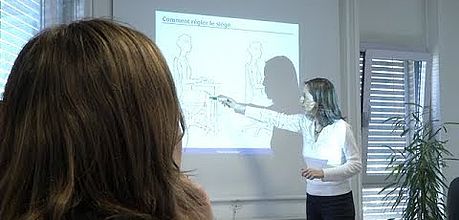 Video
Video
 Video
Video
“Hard hats must be worn on the building site” is a safety warning for construction workers. But how about in the office? To make the office a safe working space, computer work stations needs to be taken into consideration. Occupational safety and health protection in the office are anything but complicated: with just a few simple measures you can build health and safety into your daily work routine. We will show you how.
Prevention in the office is easier than you may think. Once the focus is turned on the right elements, a lot can be achieved with just a few small changes. David Vuillaume, General Secretary of the Swiss Museums Association, is surprised at how little it takes to achieve a positive effect on the health of employees. “Often it needs only a small adjustment to the way one sits or to the lighting. This is easily done.” Health protection at work is important to keep museums running successfully as the work is multifaceted and can only be carried out efficiently by healthy employees.
Sitting for a long time can take its toll on the body. This applies particularly to those who use computers and often spend hours hardly moving at all. To remain healthy at work therefore, you need the right office chair. This should have an adjustable seat back with a curve at the level of the small of the back in order to take pressure off the back. There should be an angle of at least 90° between your thighs and lower legs, with your feet flat on the floor. When you lean back in your chair, the seat back should give a little. Armrests are not absolutely necessary. Make sure that when sitting up straight your elbows rest on the table and that your shoulders are not raised but relaxed. If you have done all of this, your blood can circulate freely. What applies here: ‘the dose makes the poison’. It is recommended to adjust the sitting position and body posture several times per hour.
It is recommended to break the overall working time down into 60 percent dynamic sitting, 30 percent standing and 10 percent walking around1.
Good lighting has a positive effect on employees’ motivation and ability to concentrate, and helps to reduce errors when working. Studies show that overall productivity can be increased by 8 percent by increasing the level of lighting from 300 to 500 lux2. The best light source of all is daylight3. Daylight should be the primary light source in offices, supported by good artificial lighting. Position work stations to permit employees to see out of a window. Windows are also very important in break rooms. By providing this possibility, you are creating the basic conditions necessary for employees to recharge their batteries.
The right lighting is typically an important element in museums, emphasises David Vuillaume. “We always think of the exhibition rooms and tend to forget that the lighting in offices is important to general wellbeing, accident prevention and the quality of work.”
One usually only notices after the big push is over: headaches, squinting, tired or irritated eyes can be a sign that something is wrong. Too strong a contrast or glare could be the problem. Set up your monitor so that your line of sight is parallel to the windows in order to avoid glare and reflections. Ideally right-handers present their left shoulder to the window while left-handers present their right shoulder. This avoids a shadow being thrown over the area on which one is writing.
One should not look directly into the light source and light should also not be reflected in the monitor. Partitions and plants can offer protection from direct light. The contrast between the monitor and the surrounding area should be moderate as too strong or too weak a contrast is tiring for the eyes4.
In addition to posture and lighting, the indoor climate also contributes to wellbeing when at work. The office temperature should be between 21° and 23° Centigrade. Big temperature fluctuations should be avoided: work stations should not be exposed to excessive heat and if there is air conditioning it should be set so that it is never more than 8° Centigrade lower than the temperature outside. Ideally humidity should be between 30 and 65 percent. Occasional fluctuations above and below these levels a few times a year are harmless.
1 Cf. IGM: Ergonomisch am Bildschirm arbeiten. Frisch und entspannt durch den Arbeitstag! (2010). URL: https://www.uni-hildesheim.de/media/gleichstellung/audit_familiengerechte_hochschule/Telearbeit/IGM-Ergonomisch_am_Bildschirm_arbeiten.pdf (in German)
2 Cf. Van Bommel, van den Beld, Fassian (2004), S. 14: URL: https://www.vdi.de/uploads/media/Artikel_VAN_BOMMEL_Biologische_Wirkung_von_Licht.pdf (in German)
3 Cf. FCOS Box, Office planning chapter URL: https://www.ekas-box.ch/en/#!/office-planning/windows-natural-light
4 Cf. IGM: Beleuchtung im Büro. So geht Ihnen das richtige Licht am Arbeitsplatz auf! (2010). URL: http://www.ergo-online.de/html/service/download_area/beleuchtung_final.pdf (in German)